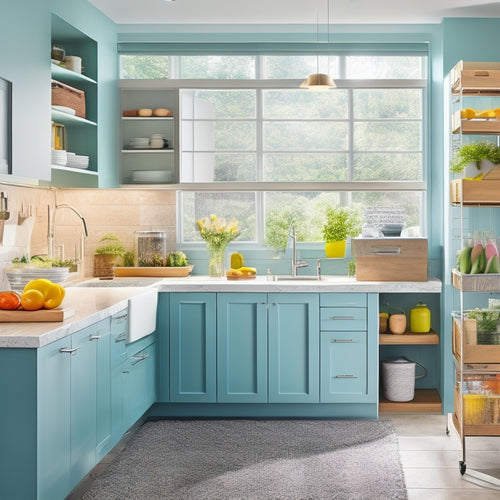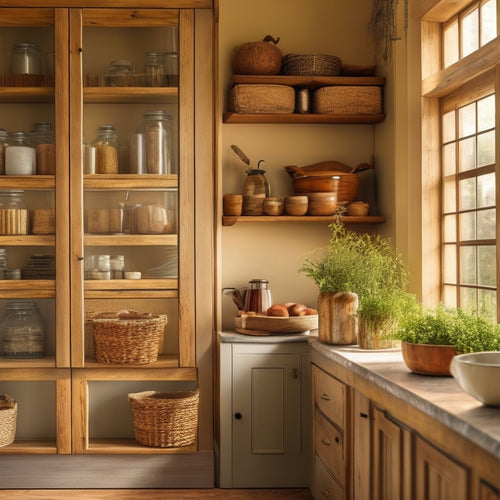
What's the Secret to Clutter-Free Kitchen Countertops?
Share
To achieve clutter-free kitchen countertops, start by sorting utensils into categories and discarding expired spices. Assign a home for each item, grouping spices by type and reserving prime spots for frequently used essentials like your coffee maker. Maximize vertical storage space with wall shelves and utilize corner cabinets efficiently with Lazy Susans. Prioritize frequently used items, labeling shelves and allocating space for utensils. By implementing these strategies, you'll be well on your way to a clutter-free kitchen. Now, discover more ways to optimize your kitchen workflow and maintain a peaceful cooking environment, one step at a time.
Key Takeaways
• Assign a home for each item to maintain organization and make cleaning easier.
• Designate specific areas for frequently used items, like coffee makers and stand mixers, to optimize counter space.
• Utilize vertical storage options, such as wall shelves and hooks, to keep infrequently used items out of the way.
• Practice a minimalist approach by evaluating the necessity of new items and avoiding impulse purchases.
• Establish a daily cleaning routine, including wiping down counters and putting away items immediately, to prevent clutter buildup.
Decluttering Kitchen Essentials First
Before you can achieve clutter-free kitchen countertops, tackle the essential items that you use daily, like knives, cutting boards, and utensils, and assess which ones are truly necessary to keep within easy reach.
Start by sorting utensils into categories, such as baking, cooking, and serving. Be honest with yourself - do you really need five wooden spoons or can you get by with two? Set aside items that are broken, duplicate, or no longer serve a purpose.
Next, turn your attention to organizing spices. Check expiration dates and discard any that are no longer fresh. Group spices by type, such as baking, savory, or sweet, and consider using a spice rack or carousel to keep them tidy.
Consider the 'first in, first out' rule to guarantee that older spices are used before they expire. By decluttering and organizing these essential items, you'll create a more efficient and peaceful kitchen environment that makes cooking and serving others a joy.
Assigning a Home for Items
Now that you've purged your kitchen of unnecessary items, it's time to assign a home for each remaining essential, ensuring everything has a designated place where it can be easily accessed and returned. This step is vital in maintaining a clutter-free kitchen.
| Item | Assigned Home |
|---|---|
| Spices | Organizing containers near the cooking zone |
| Cooking Utensils | Labeled shelves close to the cooking station |
| Oils and Vinegars | Designated cabinet with convenient access |
Maximizing Vertical Storage Space
By utilizing wall-mounted shelves, hooks, and baskets, you can effectively maximize your kitchen's vertical storage space, keeping countertops clear and freeing up valuable real estate for food preparation and cooking. This is especially important in kitchens with limited counter space, where every inch counts.
Here are some ways to make the most of your kitchen's vertical storage space:
-
Install wall shelves to store infrequently used items, such as special occasion dishes or cookbooks.
-
Hang hooks for frequently used items, like pots, pans, and utensils, keeping them within easy reach.
-
Use stackable baskets to store dry goods, like pasta, rice, or snacks, keeping them organized and out of the way.
- Consider magnetic spice strips to keep your spices organized and easily accessible.
Utilizing Corner Kitchen Cabinets
You can access valuable storage space in your kitchen by optimizing the often-wasted area in corner cabinets with clever organizational solutions. One effective way to do this is by installing a Lazy Susan in the corner cabinet. This rotating shelf allows you to easily access items that would otherwise be hidden from view, making the most of the often-hard-to-reach space.
Additionally, consider incorporating hidden storage solutions, such as drawers or shelves, to store items like spices, oils, or specialty cookware.
Another common challenge in corner cabinets is the 'blind corner,' where items can get lost or forgotten. To combat this, consider installing pull-out shelves or baskets that allow you to easily retrieve items from the back of the cabinet. This won't only free up space but also reduce clutter and make your kitchen feel more organized.
Prioritizing Frequently Used Items
As you work to maintain clutter-free kitchen countertops, identify the items you use most frequently and allocate prime real estate for them, guaranteeing easy access and streamlining your cooking workflow. This means designating specific areas for your go-to appliances, cookware, and utensils. By doing so, you'll save time and reduce frustration while preparing meals for yourself and others.
Here are four essential items to prioritize:
-
Coffee maker: If you're a daily coffee drinker, reserve a prime spot for your coffee maker to guarantee easy access and quick brewing.
-
Frequently used spices: Keep your most-used spices organized and within reach by designating a specific area, such as a spice rack or carousel, near your cooking station.
-
Sorting utensils: Allocate a designated drawer or container for your most-used utensils, such as wooden spoons, whisks, and spatulas, to keep them organized and easily accessible.
- Stand mixer: If you're an avid baker, consider reserving a prime spot for your stand mixer to guarantee easy access and convenient use.
Creating a Coffee Station
Designate a specific area of your countertop as a coffee station, where you can centralize your coffee maker, coffee beans, and accessories, making your morning routine more efficient and enjoyable. This dedicated space will help you stay organized and focused, ensuring you have everything you need within arm's reach.
Consider a coffee bar setup with built-in storage solutions, such as a cabinet or shelves, to keep your supplies tidy. You can also add a few decorative touches, like a vase or a small plant, to create a stylish coffee nook.
When organizing your supplies, group similar items together, like coffee beans, creamers, and sweeteners. Use baskets, bins, or canisters to store these items, keeping them visible and easily accessible. Label each container so you can quickly find what you need.
Managing Cords and Appliances
Daily, cords and appliances clutter your countertops, making it challenging to maintain a sense of organization and calm in your kitchen. To regain control, implementing effective cable management and appliance storage strategies is crucial.
Here are some practical tips to help you minimize clutter:
-
Designate a charging station: Assign a specific area, such as a drawer or a shelf, to store and charge your devices, keeping cords organized and out of sight.
-
Invest in cable organizers: Use cable management tools, like cable ties or cord organizers, to keep cords tidy and prevent tangles.
-
Choose multi-functional appliances: Opt for appliances that serve multiple purposes, reducing the number of gadgets on your countertops.
- Utilize vertical storage: Install shelves, hooks, or a pegboard to store infrequently used appliances, freeing up valuable counter space.
Designating a Baking Zone
You can optimize your kitchen's workflow by allocating a specific area for baking, keeping all necessary tools and ingredients within easy reach. This dedicated space will streamline your baking process, making it more efficient and enjoyable.
Start by designating a specific countertop or island as your baking zone. Then, organize your utensil drawer by categorizing and storing baking-specific tools, such as whisks, spatulas, and measuring cups, in an easily accessible area. Create pantry labels to identify the storage containers holding your baking staples, like flour, sugar, and baking powder.
Next, optimize your spice rack by grouping baking spices, like cinnamon, nutmeg, and vanilla, together for quick access. Labeling your baking supplies, such as baking sheets, muffin tins, and cake pans, will also help you quickly identify what you need.
Implementing a "One In, One Out" Rule
Every time you acquire a new kitchen gadget or ingredient, get rid of an old one to maintain a balanced and organized kitchen. This 'one in, one out' rule is a simple yet effective way to prevent clutter from building up on your countertops. By adopting this approach, you'll avoid the accumulation of unnecessary items and secure that your kitchen remains a functional and peaceful space.
Here are some tips to help you implement this rule:
-
Designate a 'landing strip': Choose a specific area, like a tray or basket, where you'll place new items before deciding whether to keep or discard them.
-
Assess your storage solutions: Take stock of your kitchen's storage capacity and identify areas where you can optimize storage to make room for new items.
-
Practice a minimalist approach: Be honest with yourself about whether you really need a new gadget or ingredient. If not, consider donating or recycling it.
- Schedule regular decluttering sessions: Set aside time each month to review your kitchen items and get rid of anything that's no longer serving a purpose.
Maintaining a Daily Cleaning Routine
Three simple habits can help you maintain a clutter-free kitchen countertop: wiping down the counters after each meal, putting away items immediately after use, and dedicating a few minutes each day to tidying up.
By incorporating these habits into your daily routine, you'll be able to keep your kitchen counters organized and clutter-free.
Start by wiping down the counters after each meal to prevent crumbs and spills from building up. This will also help prevent cross-contamination of bacteria and germs.
Next, make it a habit to put away items immediately after use, such as utensils, appliances, and ingredients. This will help keep your countertops clear and prevent clutter from accumulating.
To take your daily cleaning routine to the next level, consider implementing weekly meal planning to help you stay organized and on top of your kitchen tasks. Additionally, invest in efficient storage solutions, such as baskets, bins, and shelves, to keep frequently used items within easy reach.
Frequently Asked Questions
How Do I Deal With Clutter From Kitchen Gadgets I Rarely Use?
You tackle clutter from rarely used kitchen gadgets by adopting decluttering strategies, embracing a minimalist kitchen mindset, and utilizing organization hacks, like storing unused gadgets in labeled bins or donating them to benefit others.
Can I Repurpose Old Furniture for Kitchen Countertop Storage?
"You breathe new life into old treasures by upcycling furniture into creative storage solutions, turning that vintage sideboard into a kitchen island or those antique crates into shelves, giving your kitchen a functional, eclectic charm."
What if I Have Limited Kitchen Countertop Space to Begin With?
You face a common challenge: limited kitchen countertop space. To overcome this, you'll need to maximize vertical space with wall-mounted shelves or racks, and find creative solutions like foldable or multi-functional items to optimize storage.
How Often Should I Re-Evaluate My Kitchen Countertop Organization System?
You'll want to re-evaluate your kitchen countertop organization system every 3-6 months, considering your time management and adopting a minimalist approach to guarantee it remains functional and efficient, serving you and your loved ones.
Are There Any Eco-Friendly Options for Kitchen Countertop Storage Materials?
As you envision a serene kitchen oasis, you're likely seeking sustainable solutions. Look for green countertop options made from recycled materials, like reclaimed wood or repurposed glass, offering an environmentally friendly way to store kitchen essentials while nurturing the planet.
Related Posts
-

Roll-Out Trays for Modular Kitchen Cabinets
Roll-out trays are the perfect addition to your modular kitchen cabinets, enhancing both accessibility and organizati...
-

Sink Storage Solutions for Open-Concept Kitchens
To maximize storage in your open-concept kitchen, focus on clever under-sink solutions and vertical space utilization...
-

Freestanding Pantry Units for Farmhouse Kitchen Style
Freestanding pantry units perfectly blend beauty and function in your farmhouse kitchen. They maximize storage while ...


